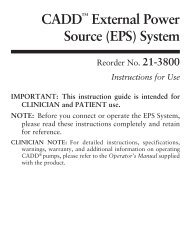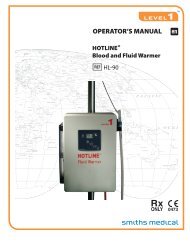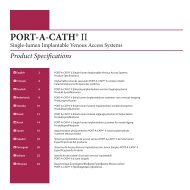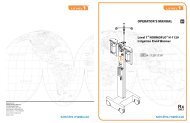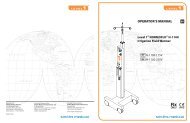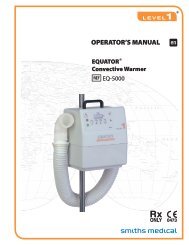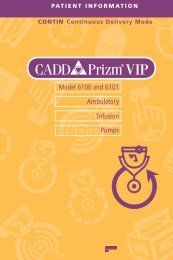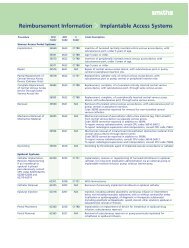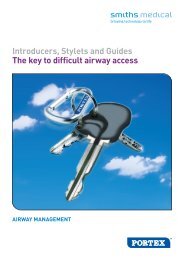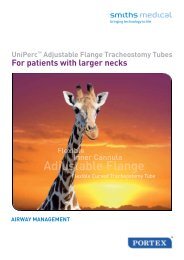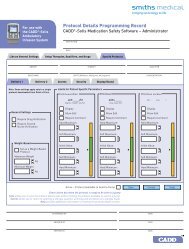40-5124-24C IFU, ProPort.indd - Smiths Medical
40-5124-24C IFU, ProPort.indd - Smiths Medical
40-5124-24C IFU, ProPort.indd - Smiths Medical
You also want an ePaper? Increase the reach of your titles
YUMPU automatically turns print PDFs into web optimized ePapers that Google loves.
1.<br />
2.<br />
Stabilize the portal using the thumb and finger. Confirm that the flow is not<br />
obstructed and that no leaks exist by flushing the system, using a non-coring<br />
PORT-A-CATH® access needle and a 10-ml or larger syringe filled with<br />
heparin solution (10 to 100 IU/ml).<br />
Establish a heparin lock by continuing to inject heparin solution while withdrawing<br />
the needle.<br />
NOTE: The above step must be done to minimize reflux of blood into the<br />
catheter.<br />
D. Site Closure<br />
1.<br />
2.<br />
Suture the portal to the underlying muscle fascia when possible or to subcutaneous<br />
tissue using permanent sutures in all available suture holes to prevent<br />
the portal from changing position after placement.<br />
NOTE: The <strong>ProPort</strong> has two open suture holes near the outlet tube and<br />
two pierceable suture holes in back which can be pierced with a standard<br />
suture needle.<br />
Close the portal pocket, ensuring that the portal does not lie directly under<br />
the incision.<br />
E. Postoperative Care<br />
Observe the patient for any potential complications immediately following<br />
system implantation.<br />
VI. INSTRUCTIONS FOR SYSTEM<br />
ACCESS<br />
A. Determining System Integrity<br />
WARNING: Do not initiate injection or infusion therapy until system integrity is<br />
confirmed. If integrity is not confirmed, damage to the system may exist, which<br />
may include but is not limited to, catheter rupture or fragmentation with possible<br />
embolization, or drug extravasation.<br />
NOTE: This procedure requires aseptic technique and sterile equipment.<br />
Before starting an injection or infusion therapy it is essential to confirm system<br />
integrity and assure that no system damage exists by completing steps 1 through<br />
10 below.<br />
If system integrity is in doubt as a result of any of the following steps, further<br />
verification will be required. This may consist of radiography (fluoroscopy, x-ray).<br />
If radiography is used, the patient should be placed in an upright, arms-at-sides<br />
position. 1,2,5,7,8<br />
1. Inquire and/or observe whether the patient has experienced any symptoms<br />
that might warn of catheter fragmentation and/or catheter embolization since<br />
the system was last accessed; for example, episodes of shortness of breath,<br />
chest pain, or palpitations. If any of these symptoms are reported, an x-ray is<br />
recommended to determine if there are problems with the catheter.<br />
2. Examine and palpate the portal pocket and catheter tract for erythema, swelling,<br />
tenderness, or infection which might indicate system leakage. If system leakage<br />
is suspected, an x-ray is recommended to determine if there are problems<br />
with the system.<br />
3. Set up the sterile field and supplies.<br />
4. Prepare the site for the injection or infusion.<br />
5. Anesthetize the site for needle puncture, if desired.<br />
6. Using a 10-ml or larger syringe, prime the non-coring PORT-A-CATH® access<br />
needle and any attached extension set to remove all air from the fluid path. Do<br />
not use standard hypodermic needles, as these will damage the septum and<br />
may cause leakage.<br />
7. Locate the portal by palpation and immobilize it using thumb and fingers of<br />
the nondominant hand.<br />
8. Insert the non-coring needle through the skin and portal septum at a 90°<br />
angle to the septum. To avoid injection into the subcutaneous tissue, slowly<br />
advance the needle until it touches the bottom of the portal chamber (Figure 12).<br />
9.<br />
10.<br />
WARNING: Do not tilt or rock the needle once the septum is punctured as this<br />
may cause fluid leakage or damage to the septum.<br />
Aspirate for blood return. Difficulty in withdrawing blood may indicate<br />
catheter blockage or improper needle position.<br />
WARNING: Do not exceed a pressure of <strong>40</strong> psi [2.76 bar; 275 kPa] when flushing<br />
fluid through the system. Excessive pressure may damage the system and can<br />
easily be generated with power injectors or with all syringes. The smaller the<br />
syringe, the higher the pressure that can be generated with the same applied<br />
force. Do not continue attempts to flush the system if extreme resistance is<br />
encountered. Damage due to excessive pressure may include but is not limited<br />
to, catheter rupture or fragmentation with possible embolization, or drug<br />
extravasation.<br />
Using a second 10-ml or larger syringe, flush the system with 10-ml of normal<br />
saline, taking care not to apply excessive force to the syringe. Difficulty in<br />
injecting or infusing fluid may indicate catheter blockage.<br />
During this saline flush, observe the portal pocket and catheter tract for swelling<br />
and inquire or observe whether the patient is experiencing burning, pain, or<br />
discomfort at the portal site. If any of these symptoms are noted and/or swelling<br />
of the portal pocket and catheter tract is observed, fluid extravasation into the<br />
portal pocket or catheter tract should be suspected.<br />
A.1 System Integrity is Verified – Portal Will<br />
Not Be Used Immediately<br />
1. Attach a 10-ml or larger syringe filled with 5 ml of heparin solution (10 to 100<br />
IU/ml).<br />
2. Establish a heparin lock by instilling 5 ml of heparin solution (10 to 100<br />
IU/ml). To maintain positive pressure, clamp the extension set tubing while<br />
injecting the last 0.5 ml of heparin solution.<br />
3. Withdraw the non-coring needle.<br />
NOTE: If using a straight, non-coring needle, stabilize the portal and withdraw<br />
the syringe and non-coring needle while injecting the last 0.5 ml.<br />
4. Discard the needles and syringes according to established protocol.<br />
1.<br />
2.<br />
3.<br />
4.<br />
5.<br />
A.2 System Integrity Is Verified – Injection<br />
Or Infusion Will Be Initiated<br />
Immediately<br />
Secure the non-coring needle according to established protocol. Replace the<br />
syringe with an injection cap, IV tubing, or needleless access device.<br />
Clean the injection cap or extension set hub according to established protocol.<br />
Connect the fluid delivery system according to established protocol.<br />
NOTE: Follow the Centers for Disease Control and Prevention (CDC) guidelines<br />
or established hospital/institutional policy for changing tubing.<br />
Secure all connections.<br />
Begin the infusion or give the injection.<br />
WARNING: To avoid a possible drug precipitation and resulting catheter<br />
occlusion, thoroughly flush the system with an appropriate solution before and<br />
after each injection or infusion when administering medications that may be<br />
incompatible with one another. Refer to the manufacturer’s specific instructions<br />
and labeling for each medication before administration.<br />
7



